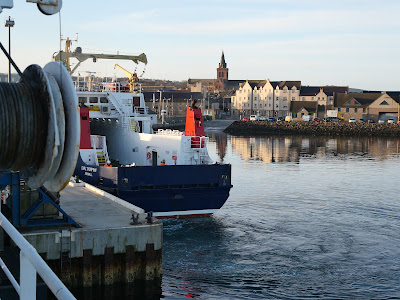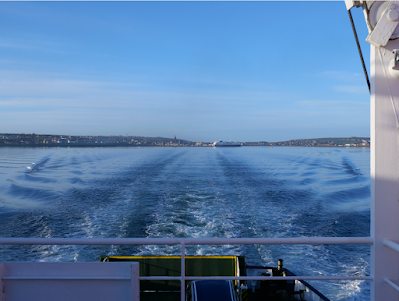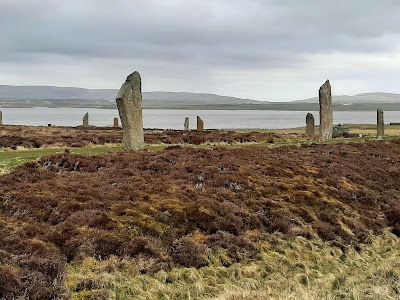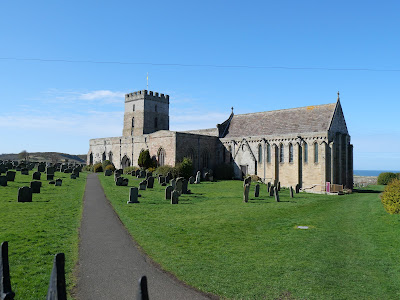.jpg) |
April 13, 2023--Queen Mary's Bath
|
In Edinburgh stands an edifice long abandoned to the doves and pigeons. Namely, Queen Mary's Bath. As buildings go, it is still mostly intact, albeit an odd looking place. And as with most everything else in Scotland, a copious amount of uncertainty exists on whether it was or wasn't a bath house.
According to the popular lore of the town folk--since like forever (or "of considerable antiquity" that may be called) --the unusual medieval building at Holyrood has long been associated with Queen Mary. Specifically, they say, it was her bath...but not just any bath. For it has also been rumored
that Queen Mary of Scots did not bathe in mere water; but rather in sweet white
wine, which she believed was good for her complexion.
Until, that is, John Pinkerton, Scottish antiquarian, came along and felt the need for further embellishment. In 1776 (about 200 years after Queen Mary's beheading by Elizabeth I) Pinkerton added to the tale.
The bathing waters were further transformed to champagne...a conversion of water to wine more or less on par with the Wedding at Cana perhaps. Per Pinkerton: "The chamber, where the Queen, whose
charms divine, Made wond’ring
nations own the pow’r of love, Oft bathed her snowy limbs in sparkling
wine, Now proves a lonely refuge for the dove.”
Pinkerton's embellishment does indicate that Queen Mary's Bath was no longer in use at least as late as the American Revolution. Pinkerton, incidentally, was not only an antiquarian. He was also a master cartographer, a historian, author, numismatist, and sadly...he was an early advocate of Germanic racial supremacy. His ideological views were, how shall we say, slightly bent?
.jpg) |
April 23, 2023--Pictish stone
|
Pinkerton's correspondence, particularly with fellow academics, is
characterized by verbal abuse...rantings that imitate one of our more modern pontificating presidential candidates. Proving the axiom that the more things change the more they remain the same.
At any rate, in two works--Dissertation on the Origins and Progress of the Scythians or Goths (1787) and Enquiry into the History of Scotland preceding the reign of Malcolm III
(1789)--Pinkerton theorized that the Picts were a race of ancient
Goths. He also suggested that England was of superior racial stock than Ireland and Wales. Or, as Pinkerton put it, "What a lion is to an ass, such is a Goth to a Celt."
He wanted to purge his country's history of all things Celt; to rid the modern world of "Celtomania" using what he perceived to be the racial superiority of the Picts--who are largely a mythic enigmatic people. Yes, there's archeological evidence of them--a stray stone here or there--that proves their existence, but scant little besides. And that opened the doorway for a charlatan like Pinkerton. He used the Picts much in the same way that Hitler did with his so-called Aryans a century and a half later.
In keeping with the times, though, Pinkerton's racist ideology lent support to continuing (indeed accelerating) the Highland Clearances which are now widely accepted as being the acts of a systematic genocide...the great replacement theory, perversely enough. Lastly, Pinkerton was known to embellish...to the point of creative forgeries. He ultimately was called out by the selfsame academians that he violently attacked, and died impoverished in France somewhere after selling his estate. We'll leave it at that.
.jpg) |
April 13, 2023--the Bath
|
Back to Edinburgh. As to archeological and bibliographical evidence, Queen Mary's Bath was built in or about 1565, which happens to fall within two years give or take of her being deposed. So, the bath was indeed built when Queen Mary was still in power in Scotland. Bibliographically, the bath does not appear in a map of Edinburgh in 1544. So likely it was built sometime after that. Of course, that's somewhat like Carl Sagan's famous observation: "Absence of evidence is not evidence of absence."
Nor does the bath appear in Holinshed's Chronicles of England, Scotland, and Ireland published in 1577 (attributed to Rowland Johnson) when it should have been if one is consistent. In 1647, about 80 years after its construction, however, the bath is illustrated in Gordon of Rothiemay's pictorial map of Edinburgh. And more particularly it is shown in a survey of 1671, standing just beyond the corner of the King's Privy Garden, its entrance being about 20 yards from the "caichepelle"--or tennis court.
Okay. So what was it?
Ignoring bathing in wine of course, some accounts have it as being a tennis pavilion. If so, this would make it the oldest tennis pavilion in the world. And they do have their arguments. Others say it was a dovecot all along...which stretches things a bit. Still others have the bath as being a summer house, or a garden pavilion for the then newly created North privy gardens on the grounds of the palace at Holyroodhouse. Some say it was the house of the watchman over the royal gardens. Dubious, but hey.
.jpg) |
April 13, 2023--Queen Mary's Bath jutting out in the pavement from city tour bus
|
.jpg) |
April 13, 2023--Holyrood
|
And some (ever inclining their ear toward salacious gossip) say it was an intimate banquet house. They too have their arguments. Adding to the mystery, in 1852 the bath was reconditioned. For a time, it became quite a tourist attraction. In this restoration work, a richly-inlaid dagger was found, hidden in
the boarding of the bath's roof; its whereabouts now are not known to this author.
Far be it from me to repeat such lascivious details, but this dagger was rumored to have been used in the infamous murder of David Rizzio, Queen Mary's private secretary who was stabbed 56 or 57 times in Queen Mary's private bedchambers. At some point you stop counting.
Rizzio, an ambitious Italian, is rumored to have impregnated Mary with James VI (of Scotland)/James I (of England). There are certainly some questions. Lord Darnley, the King consort, ultimately grew jealous of their friendship. For his part, Rizzio was apparently not particular. Early on, he "insinuated himself in the favors of Lord
Darnley so far," according to David Calderwood (Scottish Presbyterian minister at Jedburgh, c. 1575-October 29, 1650) "that they would lie some times in one bed together."
Apparently in his other pursuits, Rizzio was discovered hiding in the closet of Queen Mary's bedchamber in the middle of the night dressed only in a fur gown over his shirt (at least according to a report by a French diplomat to the court at the time). So Lord Darnley set a course of revenge.
.jpg) |
13 Apr 23--Rizzio's purported grave
|
On March 9, 1566, Mary was having dinner with Rizzio and a few ladies-in-waiting. Darnley intruded, accused his wife of adultery, and then had a posse of nobles murder Rizzio. At first, Rizzio tried to hide behind Queen Mary who was then six months pregnant with James VI/James I. He was seized after one of the intruders (alleged by Queen Mary afterwards) held a gun at her pregnant belly. Another threatened to stab her.
And after a violent struggle, Rizzio was stabbed 56 (or 57) times. He was dragged through the bedchamber into the adjacent Audience Room, after which, his body was thrown down the main staircase and stripped of his jewels and fine clothes. In all, there were 15 conspirators involved in Rizzio's murder, and two clergy--one of whom may have been none other than John Knox, depending on who you ask.
Rizzio was buried that same night in an unmarked grave in the grounds of Holyrood Abbey. Widely circulated rumors also have it that Queen Mary had his body interred at her father's tomb, which did her case little good. Some say Rizzio (or Riccio) was re-buried at Canongate Kirk...a doubtful claim as the Kirk had not yet been built.
.jpg) |
April 13, 2023--Knox House
|
Just over a year later, in April 1567, Darnley would himself be murdered unceremoniously, some say with Queen Mary's assistance. Technically, she was thought to be an accessory to regicide. And it was this that led her to seek safe haven with her cousin--Queen Elizabeth I of England.
Out of the frying pan and into the fire. For
her alleged role in the conspiracy against Elizabeth I, Mary, Queen of Scots was executed in February 1587. The rest is history.
So, what was it? The reality is, no one knows for sure. If I had to hazard a guess, I'd go with a tennis pavilion as most likely. But it does have quite a story line associated with it.
If it weren't true, it'd be a thing of fiction.


















.jpg)

.jpg)


















.jpg)
.jpg)
.jpg)
.jpg)

.jpg)

.jpg)
.jpg)
.jpg)
.jpg)
.jpg)
.jpg)
.jpg)